1997 PONTIAC BONNEVILLE wheel
[x] Cancel search: wheelPage 285 of 405

Brake Wear
Your Pontiac has front disc brakes and rear drum brakes.
Disc brake pads have built-in wear indicators that make
a
high-pitched warning sound when the brake pads are worn
and new pads are needed. The
sound may come and go or
be heard all the time your vehicle is moving (except when
you are pushing on the brake pedal fiiy).
Le brake wear warning sound means that soon
your brakes won’t work well. That could lead to
an accident. When you hear the brake wear
warning sound, have
your vehicle serviced.
I NOTICE:
Continuing to drive with worn-out brake pads
could
result in costly brake repair.
Some driving conditions or climates may cause a brake
squeal when the brakes are first applied or lightly
applied. This does not mean something
is wrong
with your brakes.
See “Caliper/Knuckle Maintenance Inspection” in
Section
7 of this manual under Part C “Periodic
Maintenance Inspections.”
Properly torqued wheel nuts are necessary to help
prevent brake pulsation. When tires are rotated, inspect
brake pads for wear
and evenly torque wheel nuts in the
proper sequence to
GM specifications.
Your rear drum brakes don’t have wear indicators, but if
you ever hear a rear brake rubbing noise, have the rear
brake linings inspected.
Also, the rear brake drums should
be removed
and inspected each time the tires are removed
for rotation or changing. When you have the front brakes
replaced, have the rear brakes inspected, too.
Brake linings
should always be replaced as complete
axle sets.
See “Brake System Inspection”
in Section 7 of this manual
under Part
C 44Periodic Maintenance Inspections”.
6-32
ProCarManuals.com
Page 297 of 405
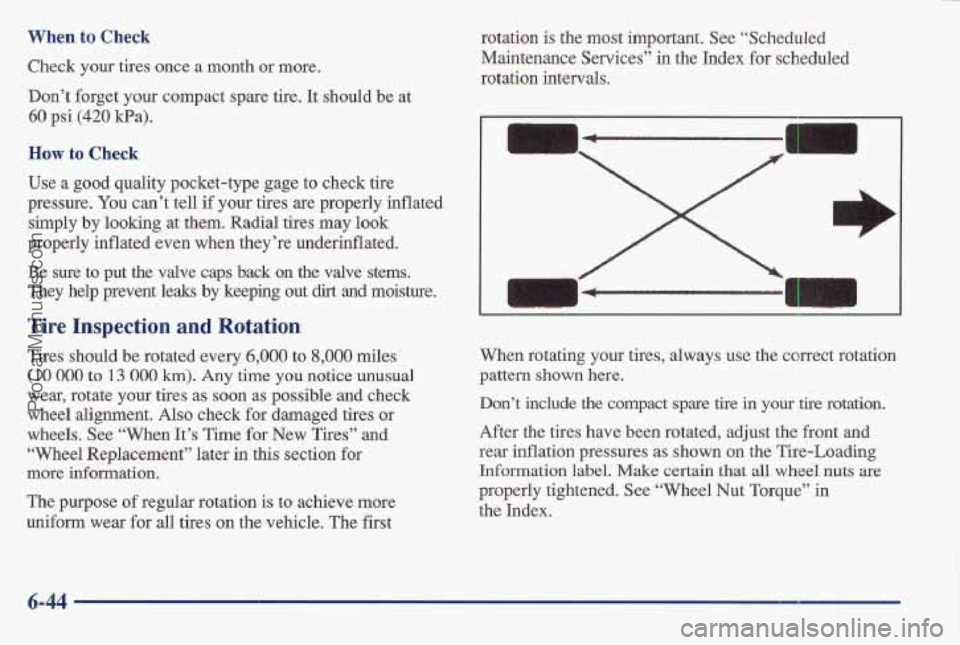
When to Check
Check your tires once a month or more.
Don’t forget your compact spare tire. It should be at
60 psi (420 kPa).
How to Check
Use a good quality pocket-type gage to check tire
pressure.
You can’t tell if your tires are properly inflated
simply by looking at them. Radial tires may look
properly inflated even
when they’re underinflated.
Be sure to put
the valve caps back on the valve stems.
They help prevent leaks by keeping out
dirt and moisture.
Tire Inspection and Rotation
Tires should be rotated every 6,080 to 8,000 miles
(10 000 to 13 000 h). Any time you notice unusual
wear, rotate your tires as soon as possible and check
wheel alignment. Also check for damaged tires or
wheels. See “When It’s Time for New Tires’’
and
“Wheel Replacement” later in this section for
more information.
The purpose
of regular rotation is to achieve more
unifQm
wear .- - for .. dl tires ., on . h .. vehicle. . The first rotation
is the most important. See “Scheduled
Maintenance Services” in the Index for scheduled
rotation intervals.
m I
n
7
When rotating your tires, always use the correct rotation
pattern shown here.
Don’t include the compact spare tire in your tire rotation.
After the tires have been rotated, adjust the front and
rear inflation pressures
as shown on the Tire-Loading
Information label.
Make certain that all wheel nuts are
properly tightened. See “Wheel Nut Torque” in
the Index.
4-44
ProCarManuals.com
Page 298 of 405

When It’s Time for New Tires
Rust or dirt on
a wheel, or on the parts to which
it is fastened, can make wheel nuts become loose
after a time. The wheel could come off and cause
an accident. When you change
a wheel, remove
any rust or dirt from places where the wheel
attaches to the vehicle. In an emergency,
you can
use
a cloth or a paper towel to do this; but be
sure
to use a scraper or wire brush later, if you
need to, to get all the rust or dirt off. (See
“Changing
a Flat Tire” in the Index.)
-1 One way to tell when it’s
time for new tires
is to
check the treadwear
indicators, which will
appear when
your tires have
only 1/16 inch (1.6
mm) or
less of tread remaining.
You need a new tire if any of the following statements
are true:
0 You can see the indicators at three or more places
You can see cord or fabric showing through the
0 The tread or sidewall is cracked, cut or snagged deep
around
the tire.
tire’s rubber. enough to show cord or fabric.
The tire has a bump, bulge or split.
The tire has a puncture, cut or other damage that
can’t be repaired well because of the size or location
of the damage.
6-45
ProCarManuals.com
Page 299 of 405
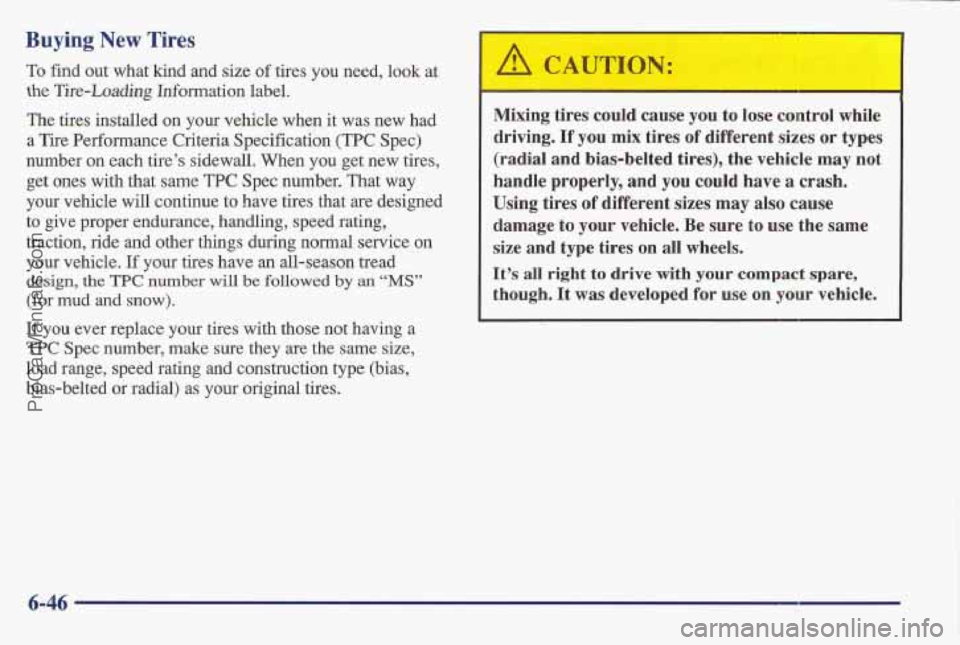
Buying New Tires
To find out what kind and size of tires you need, look at
the
Tire-Loading Information label.
The tires installed on your vehicle when it was new had
a Tire Performance Criteria Specification (TPC Spec)
numb’er on each tire’s sidewall. When you get new tires,
get ones with that
same TPC Spec number. That way
your vehicle will continue
to have tires that are designed
to give proper endurance, handling, speed rating,
traction, ride and other things during normal service
on
your vehicle. If your tires have an all-season tread
design, the TPC number will be followed by an “MS”
(for mud and snow).
If you ever replace your tires with those not having a
TPC Spec number, make sure they are the same size,
load range, speed rating and construction type (bias,
bias-belted or radial) as your original tires. Mixing tires
could cause
you to lose control w: e
driving. If you mix tires of different sizes or types
(radial and bias-belted tires), the vehicle may not
handle properly, and you could have a crash.
Using tires of different sizes may also cause
damage
to your vehicle. Be sure to use the same
size and type tires on all wheels.
It’s all right to drive with your compact spare,
though. It was developed for use on your vehicle.
6-46
ProCarManuals.com
Page 301 of 405

Temperature -- A, B, C
The temperature grades are A (the highest), B, and C,
representing the tire’s resistance to the generation of
heat and its ability to dissipate heat when tested under
controlled conditions on
a specified indoor laboratory
test wheel. Sustained high temperature can cause the
material of the tire to degenerate and reduce tire life, and
excessive temperature can lead to
sudden tire failure.
The grade
C corresponds to a level of performance
which all passenger car tires must meet under the
Federal Motor Vehicle Safety Standard
No. 109. Grades
B and A represent higher levels of performance on the
laboratory test wheel than the minimum required by law.
Warning: The temperature grade for this tire is
established for a tire that is properly inflated and not
overloaded. Excessive speed, underinflation, or
excessive loading, either separately or in combination,
can cause heat buildup and possible tire failure.
Wheel Alignment and Tire Balance
The wheels on your vehicle were aligned and balanced
carefully at the factory
to give you the longest tire life
and
best overall performance. Scheduled wheel
alignment and wheel balancing
are not
needed. However,
if you notice unusual tire wear or
your vehicle pulling one way or the other, the alignment
may need to be reset.
If you notice your vehicle
vibrating when driving on a smooth road, your wheels
may need to be rebalanced.
Wheel Replacement
Replace any wheel that is bent, cracked, or badly rusted
or corroded.
If wheel nuts keep coming loose, the wheel,
wheel bolts and wheel nuts should be replaced.
If the
wheel leaks air, replace it (except some aluminum
wheels, which can sometimes be repaired). See your
Pontiac dealer
if any of these conditions exist.
Your dealer will
how the kind of wheel you need.
Each new wheel should have the same load-carrying
capacity, diameter, width, offset and
be mounted the
same way as the one it replaces.
If you need to replace any of your wheels, wheel bolts
or wheel nuts, replace them only with new GM original
equipment parts.
This way, you will be sure to have
the right wheel, wheel bolts and wheel nuts
for your
Pontiac model.
6-48
ProCarManuals.com
Page 302 of 405
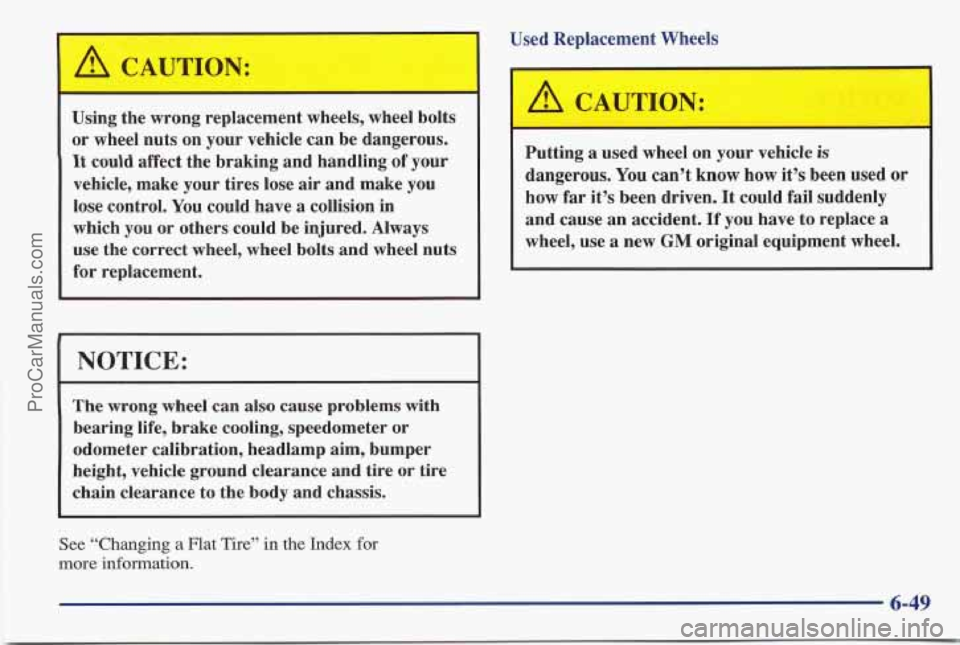
Using the wrong replacement wheels, wheel bolts
or wheel nuts on your vehicle can be dangerous.
It could affect the braking and handling of your
vehicle, make your tires lose air and make you
lose control.
You could have a collision in
which
you or others could be injured. Always
use the correct wheel, wheel bolts and wheel nuts
for replacement.
i
NOTICE:
The wrong wheel’can also cause problems with bearing life, brake cooling, speedometer or
odometer calibration, headlamp aim, bumper
height, vehicle ground clearance and tire or tire
chain clearance to the body and chassis.
See “Changing
a Flat Tire” in the Index for
more imfQmation.
Used Replacement Wheels
I A CAUTION:
I- 1
Putting a used wheel on your vehicle is
dangerous. You can’t know how it’s been used or
how
far it’s been driven. It could fail suddenly
and cause an accident.
If you have to replace a
wheel, use a new GM original equipment wheel.
6-49
ProCarManuals.com
Page 303 of 405
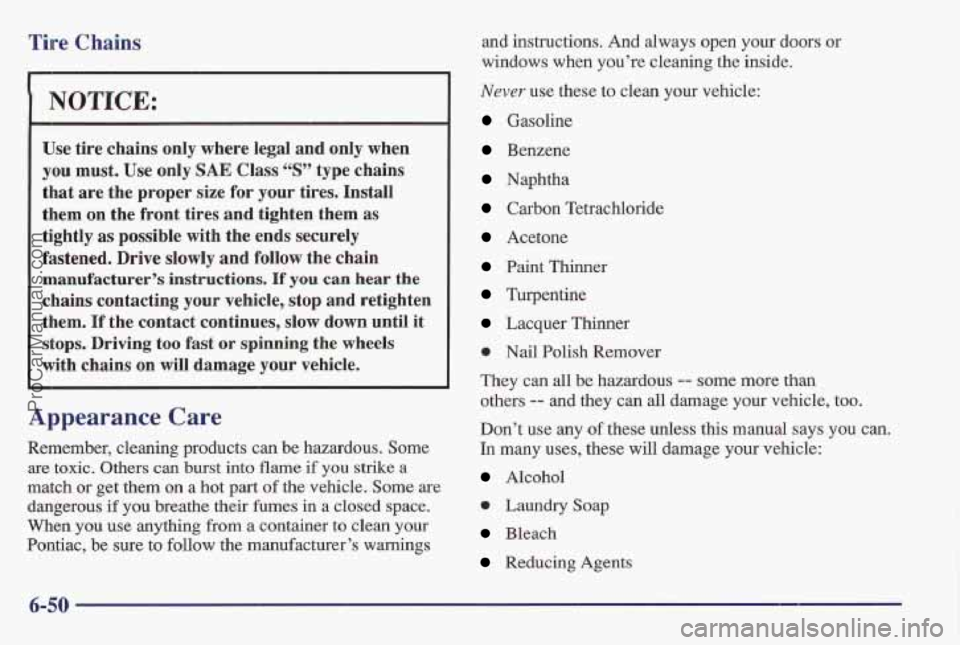
Tire Chains
I NOTICE:
Use tire chains only where legal and only when
you must. Use only SAE Class “S” type chains
that are the proper size for your tires. Install
them on the front tires and tighten them as
tightly
as possible with the ends securely
fastened. Drive slowly and
follow the chain
manufacturer’s instructions. If you can hear the
chains contacting your vehicle, stop and retighten
them.
If the contact continues, slow down until it
stops. Driving too fast
or spinning the wheels
with chains on will damage your vehicle.
Appearance Care
Remember, cleaning products can be hazardous. Some
are toxic. Others can burst into flame if you strike
a
match or get them on a hot part of the vehicle. Some are
dangerous
if you breathe their fumes in a closed space.
When you use anything from
a container to clean your
Pontiac, be sure to follow the manufacturer’s warnings and
instructions.
And always open your doors or
windows when you’re cleaning the inside.
Never use these to clean your vehicl’e:
Gasoline
Benzene
Naphtha
Carbon Tetrachloride
Acetone
Paint Thinner
Turpentine
Lacquer Thinner
rn Nail Polish Remover
They can all be hazardous
-- some more than
others
-- and they can all damage your vehicle, too.
Don’t use any
of these unless this manual says you can.
In many uses, these will damage your vehicle:
Alcohol
rn Laundry Soap
Bleach
Reducing Agents
ProCarManuals.com
Page 308 of 405
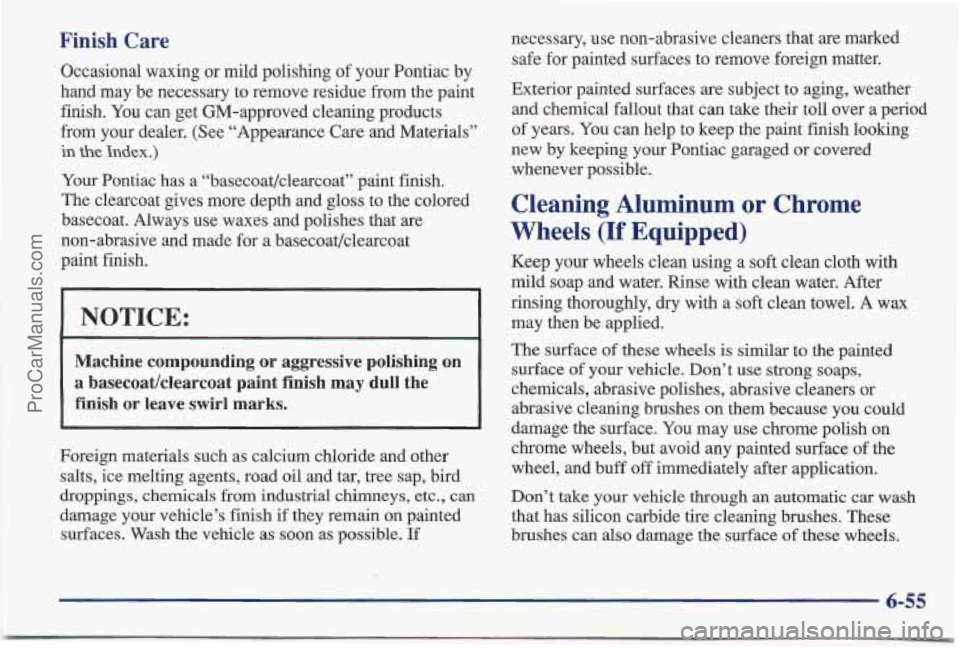
Finish Care
Occasional waxing or mild polishing of your Pontiac by
hand may be necessary to remove residue from the paint
finish. You can get GM-approved cleaning products
from your dealer. (See “Appearance Care and Materials”
in the Index.)
Your Pontiac has a “basecoat/clearcoat” paint finish.
The clearcoat gives more depth and gloss to the colored
basecoat. Always use waxes and polishes that are
non-abrasive and made for
a basecoat/clearcoat
paint finish.
NOTICE:
Machine compounding or aggressive polishing on
a basecoat/clearcoat paint finish may dull the finish or leave swirl marks.
Foreign materials such as calcium chloride and other
salts, ice melting agents, road oil and tar, tree sap, bird
droppings, chemicals from industrial chimneys,
etc., can
damage your vehicle’s finish if they remain on painted
surfaces. Wash the vehicle
as soon as possible. If
necessary, use non-abrasive cleaners that are marked
safe for painted surfaces to remove foreign matter.
Exterior painted surfaces are subject to aging, weather
and chemical fallout that can take their toll over a period
of years. You can help to keep the paint finish looking
new by keeping your Pontiac garaged or covered
whenever possible.
Cleaning Aluminum or Chrome
Wheels
(If Equipped)
Keep your wheels clean using a soft clean cloth with
mild soap and water. Rinse with clean water. After
rinsing thoroughly, dry with a soft clean towel.
A wax
may then be applied.
The surface
of these wheels is similar to the painted
surface of your vehicle. Don’t
use strong soaps,
chemicals, abrasive polishes, abrasive cleaners or
abrasive cleaning brushes on them because you could
damage the surface. You may use chrome polish on
chrome wheels, but avoid any painted surface of the
wheel, and buff
off immediately after application.
Don’t
take your vehicle through an automatic car wash
that has silicon carbide tire cleaning brushes. These
brushes can also damage the surface
of these wheels.
6-55
ProCarManuals.com